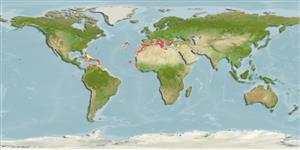Common names from other countries
Environment: milieu / climate zone / depth range / distribution range
Ecologie
; diepteverspreiding 101 - 800 m (Ref. 80197). Subtropical; 45°N - 6°N, 78°W - 36°E
Atlantic Ocean and the Mediterranean Sea.
Length at first maturity / Size / Gewicht / Leeftijd
Maturity: Lm ? range ? - ? cm Max length : 1.6 cm CL mannelijk/geslacht niet bekend; (Ref. 80197); 1.86 cm CL (female)
Maximum depth from Ref. 106425. Maximum length is based on occurrence from Ref. 80197; to be replaced with a better reference. Found on the middle and upper slopes (Ref. 79118) in mud assemblage (Ref. 102666). Non-migratory macrozooplankton feeder (Ref. 52384). Preys on euphausiids, mysids, hyperiids, insect remains, mesopelagic fish and planktonic forams (Ref. 102666).
Life cycle and mating behavior
Geslachtsrijpheid | Voortplanting | Kuitschieten | Eieren | Fecundity | Larven
Members of the order Decapoda are mostly gonochoric. Mating behavior: Precopulatory courtship ritual is common (through olfactory and tactile cues); usually indirect sperm transfer.
Bisby, F.A., M.A. Ruggiero, K.L. Wilson, M. Cachuela-Palacio, S.W. Kimani, Y.R. Roskov, A. Soulier-Perkins and J. van Hertum. 2005. (Ref. 19)
Status op de Rode Lijst van het IUCN (Ref. 130435)
Status bij CITES (Ref. 108899)
Not Evaluated
Not Evaluated
Gebruik door de mens
| FishSource |
Tools
Internet-bronnen
Estimates based on models
Preferred temperature
(Ref.
115969): 13.2 - 15, mean 14.1 (based on 112 cells).
Weerstandsvermogen
Hoog, minimale populatieverdubbelingstijd minder dan 15 maanden (K=0.55-0.75).
